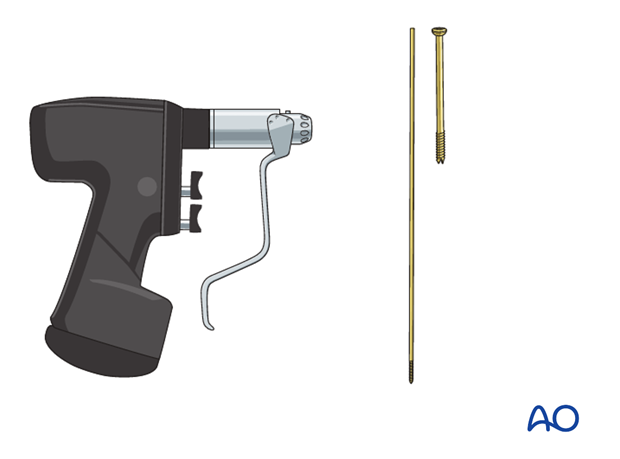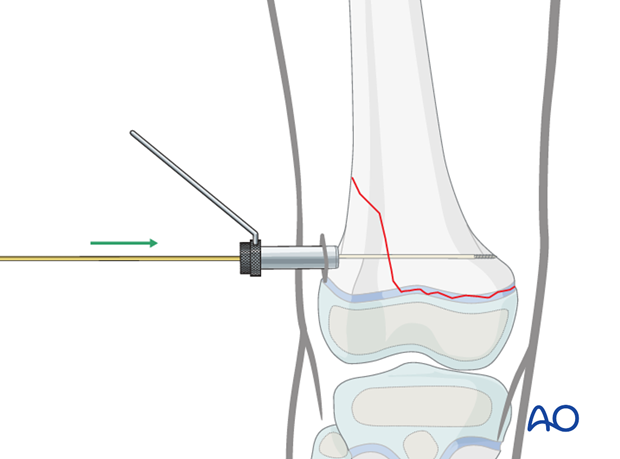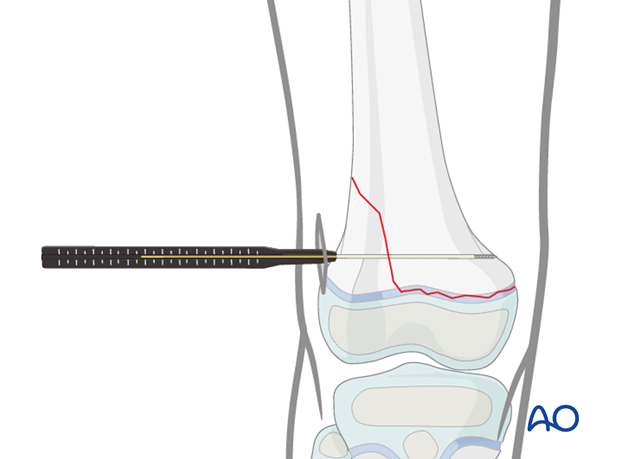Percutaneous/open reduction; screw fixation
1. General considerations
Introduction
A simple SH II fracture may be fixed with a screw through the metaphyseal wedge (Thurstan Holland fragment) and the metaphysis of the proximal fragment, parallel to the growth plate.
If the Thurstan Holland fragment is large enough, two screws may be used.

Treatment goals for SH II fractures
The main goals of treatment of these fractures are:
- Uncomplicated healing
- No secondary displacement
- Minimize injury to the growth plate
Distal femoral physeal fractures are associated with a high rate of growth arrest (30–50%). To minimize the risk, reduction should be anatomical and conducted with minimal force.

Closed vs open reduction
Start with a closed reduction. If this is unsuccessful, the block to reduction is almost always periosteum entrapped in the fracture on the side that has failed in tension.
The initial incision is made on the side where the shaft fragment is prominent. This is opposite to the side with the metaphyseal (Thurstan Holland) fragment.

Thurstan Holland fragment fixation
If the metaphyseal fragment can be reduced easily, the screws can be inserted directly on the side of the Thurstan Holland fragment.
In case of soft-tissue entrapment, insertion of screws from the other side of the Thurstan Holland fragment can be performed after open reduction.

2. Instruments and implants
As this is a minimally invasive surgical technique, only a few instruments are necessary.
4.0–7.3 mm cannulated lag screws (ideally self-drilling, self-tapping) should be used.
The following equipment is needed:
- Cannulated screw set
- Drill
- Threaded guide wire
- Image intensifier

3. Patient preparation and approaches
Patient positioning
Place the patient supine on a radiolucent table with a C-arm.

Approaches
Approach the fracture on the opposite side of the Thurstan Holland fragment. This may be attempted with a limited approach and extended for a more substantial block to reduction. This may be conducted through a:

4. Reduction
Closed reduction
Under general anesthesia with muscle relaxation, gently reduce the distal fragment with traction and manipulation.
Confirm anatomical reduction with image intensification.

Open reduction
If closed reduction cannot be obtained, proceed with an open reduction on the opposite side of the Thurstan Holland fragment.
Remove any entrapped soft tissue or bone fragments.

5. Fixation
Percutaneous screws
Perform a stab incision at the level of the planned screw insertion.
Spread the underlying soft tissues with a clamp and place a soft-tissue protector down to the bone.

Insertion of guide wire
Insert a guide wire in the metaphysis, parallel to and 1–2 cm proximal to the growth plate, until it reaches the far cortex.
If the Thurstan Holland fragment is sufficiently large for two screws, insert a second guide wire.

Screw insertion
Determine the appropriate screw length.

Choose a partially threaded screw ensuring that the thread will not cross the fracture.
Insert the screw and compress the fracture.
If the size of the Thurstan Holland fragment is sufficient, insert a second screw.

Assessment of reduction
Confirm reduction, fixation, and stability with image intensification.
If the growth plate is unstable with valgus or varus stress, consider a molded cast and/or additional fixation.
Additional fixation
If the growth plate is unstable after the placement of the screw(s) insert smooth K-wires across the growth plate and fracture from the lateral and medial femoral condyles. The exact K-wire configuration depends on the fracture characteristics.
More robust fixation including a temporary plate crossing the physis may be considered.

Wound closure
Close the incision in a standard manner with resorbable sutures.

6. Final assessment
Check implant position and fracture reduction with image intensification.
Use clinical examination to check lower extremity alignment.

7. Additional immobilization
This construct usually requires protected weight bearing and knee immobilization with a molded long leg cast or brace for 3–6 weeks.

8. Aftercare
Immediate postoperative care
The patient should get out of bed and begin ambulation with crutches on the first postoperative day.
In most cases the postoperative protocol will be touch-weight bearing for the first 4 weeks.

Analgesia
Routine pain medication is prescribed for 3–5 days postoperatively.
Neurovascular examination
The patient should be examined regularly, to exclude neurovascular compromise.
With displaced high-energy fractures watch for signs of delayed vascular problems.
Compartment syndrome, although rare, should be considered in the presence of severe swelling, increasing pain, and changes to neurovascular signs.
Discharge care
Discharge from hospital follows local practice and is usually possible after 1–3 days.
Mobilization
The patient should ambulate with crutches.
In stable fractures the knee is immobilized in a removable brace and range-of-motion exercises can begin early in the postoperative phase.
For the more unstable or comminuted fractures, range-of-motion exercises will begin after cast removal.
Follow-up
Clinical and radiological follow-up is usually undertaken 2 weeks postoperatively.
Cast and K-wire removal
Physeal fractures heal quickly and cast and K-wires are typically removed 3–6 weeks postoperatively.
Follow-up for growth deformity
All patients with physeal fractures of the distal femur should have clinical and radiological examination 8–12 weeks postoperatively to assess for signs of physeal growth disturbance or resumption of growth.
Examination should be repeated at intervals until resumption of normal growth is documented. This can be seen as a horizontal growth line (Harris line) that is parallel to the entire physis on both AP and lateral views.
A growth line that converges towards the growth plate may be the earliest sign of growth arrest and should prompt investigation/treatment or referral as appropriate.

Clinical assessment of leg length and alignment is recommended at one-year.
Clinical assessment of leg length uses a tape measure from the ASIS to the medial malleolus.

If there is any concern about leg length discrepancy or malalignment, long leg x-rays are recommended.
Leg length is measured from the femoral head to the ankle joint.

Implant removal
If symptoms develop, screws can be removed once the fracture is completely healed, usually 6–12 months postoperatively.













